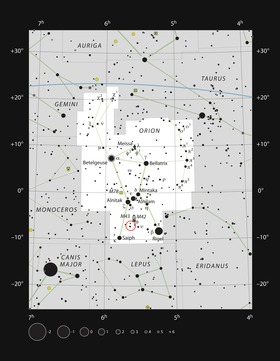V883 Orionis
Appearance
| Observation data Epoch Equinox | |
|---|---|
| Constellation | Orion |
| Right ascension | 05h 38m 18.1s[1] |
| Declination | −07° 02′ 26″[1] |
| Characteristics | |
| Variable type | FU Ori |
| Astrometry | |
| Proper motion (μ) | RA: 3.339[2] mas/yr Dec.: -2.045[2] mas/yr |
| Parallax (π) | 3.7093 ± 0.4356 mas[2] |
| Distance | approx. 900 ly (approx. 270 pc) |
| Details | |
| Mass | 1.29 ± 0.02[3] M☉ |
| Luminosity (bolometric) | 400[3] L☉ |
| Age | 0.5[3] Myr |
| Other designations | |
V883 Ori, HBC 489 | |
| Database references | |
| SIMBAD | data |
V883 Orionis is a protostar in the constellation of Orion. It is associated with IC 430 (Haro 13A), a peculiar Hα object surveyed by Guillermo Haro in 1952.[4] It is assumed to be a member of the Orion Nebula cluster at 414±7 pc,[3] although the Gaia Data Release 2 parallax suggests a closer distance.[2]
V883 Orionis, like most protostars, is surrounded by a circumstellar disc of dust. The dust has a water snow line, a certain distance where the stellar irradiance from the star is low enough that water can freeze to snow. The water snow line was directly imaged by ALMA, when a stellar outburst increased the amount of insolation and pushed the line out farther.[3]
Gallery
-
Artist's impression of the planet-forming disc around V883 Orionis
-
Informative video about the planet-forming disc around V883 Orionis
-
Artist's impression of the water snow line around V883 Orionis, detected with ALMA
-
IC 429 and IC 430 next to the star 49 Ori
References
- ^ a b "V883 Ori". SIMBAD. Centre de données astronomiques de Strasbourg. Retrieved 20 February 2017.
- ^ a b c d Brown, A. G. A.; et al. (Gaia collaboration) (August 2018). "Gaia Data Release 2: Summary of the contents and survey properties". Astronomy & Astrophysics. 616. A1. arXiv:1804.09365. Bibcode:2018A&A...616A...1G. doi:10.1051/0004-6361/201833051. Gaia DR2 record for this source at VizieR.
- ^ a b c d e Cieza, Lucas A.; et al. (2016). "Imaging the water snow-line during a protostellar outburst". Nature. 535 (7611): 258–261. arXiv:1607.03757. Bibcode:2016Natur.535..258C. doi:10.1038/nature18612. PMID 27411631.
- ^ Allen, D. A.; Strom, K. M.; Grasdalen, G. L.; Strom, S. E.; Merrill, K. M. (1975). "Haro 13a: A Luminous, Heavily Obscured Star in Orion?". Monthly Notices of the Royal Astronomical Society. 173: 47P. Bibcode:1975MNRAS.173P..47A. doi:10.1093/mnras/173.1.47P.



